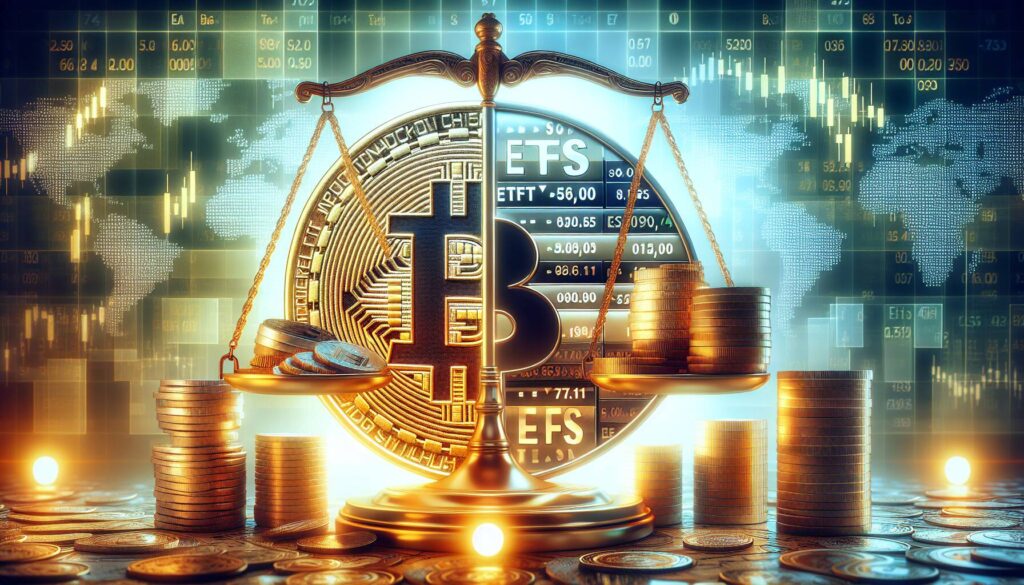In recent developments, the cryptocurrency market has experienced relative stability over the past 24 hours, with Bitcoin holding its ground above $94,000 as traders closely monitor key resistance levels. Notably, exchange-traded funds (ETFs) linked to cryptocurrencies have seen a significant surge in inflows, attracting over $590 million on Monday alone. This marks a noteworthy trend, as it is the first week of inflows since late March, reflecting growing investor interest in Bitcoin as a safe-haven asset.
Leading the charge in these inflows is BlackRock’s IBIT fund, which garnered a remarkable $970 million. Conversely, Ark’s ARKB experienced a notable outflow, losing $200 million. Despite this varied performance among funds, the broader market remained largely unchanged, with other major cryptocurrencies such as XRP, ether (ETH), Cardano’s ADA, and BNB Chain’s BNB maintaining a steady course, while Solana’s SOL faced a slight dip of 2%. The notable exception is Monero (XMR), which saw an 8.5% decrease after an unusual 40% surge the day before, linked to a significant transaction involving a hacker swapping over $330 million of Bitcoin.
In a positive turn, mid-cap cryptocurrency Nexo (NEXO) has seen a substantial 8% increase following its announcement to re-enter the U.S. market, focusing on artificial intelligence applications after a two-year regulatory hiatus. Traders are also looking ahead to essential economic indicators like GDP and unemployment data set to be released in the U.S. this week, which could provide further insight into market positioning.
“Market sentiment has been somewhat muted due to recent U.S. tariffs, but Bitcoin and the broader crypto market have sustained gains,” noted Jeff Mei, COO at BTSE. “The U.S. dollar continues to dip, as institutional investors diversify their holdings, which may explain Bitcoin’s strong demand.”
This decline in the dollar index, which has dropped nearly 6% in the past month — its steepest fall since 2022 — has sparked interest among investors in cryptocurrencies as an alternative. Meanwhile, the connection between Bitcoin and the M2 money supply is gaining traction, with analysts suggesting that increases in this supply could encourage individuals to invest in Bitcoin as a hedge against inflation.
“While we are cautious about overemphasizing this correlation, we remain optimistic about Bitcoin in the medium term due to anticipated monetary and fiscal easing amid economic slowdowns,” stated Augustine Fan, head of insights at SignalPlus.

Bitcoin and Crypto Market Update
The current state of Bitcoin and the broader crypto markets has seen some significant developments that may impact investor sentiment and strategies. Here are the key points:
- Stable Prices:
Bitcoin and other cryptocurrencies exhibited little change recently, with BTC holding above $94,000.
- ETFs Attracting Inflows:
Exchange-traded funds (ETFs) tracking Bitcoin saw over $590 million in inflows, marking a positive trend for the first time since March.
- Investor Sentiment Shift:
Bitcoin is gaining reputation as a safe-haven asset among investors amid economic uncertainties.
- Major ETF Performances:
- BlackRock’s IBIT led with inflows of $970 million.
- Ark’s ARKB experienced outflows of $200 million.
- Market Fluctuations:
Other cryptocurrencies, such as XRP and ether, remained relatively flat despite Bitcoin’s gains, while Monero saw a significant drop after a volatile shift.
- Regulatory Moves:
Nexo is planning a return to the U.S. market focused on AI applications after a two-year hiatus, highlighting ongoing regulatory developments.
- Economic Indicators Impact:
Upcoming U.S. economic data releases are anticipated to influence market positioning and sentiment going forward.
- Dollar Index Decline:
The U.S. dollar has fallen nearly 6% in the past month, prompting institutional investors to seek alternatives such as Bitcoin.
- Correlation with M2 Money Supply:
There is a growing narrative linking Bitcoin prices to the M2 money supply changes, where an increase could lead to higher Bitcoin prices.
“One of the recent and prevailing narratives suggests that BTC is about to break higher as a delayed reaction to the increase in M2 money supply.” – Augustine Fan, head of insights at SignalPlus
Crypto Markets: A Noisy Landscape of Opportunities and Risks
The recent performance of Bitcoin and the crypto markets reflects a dynamic interplay of investor sentiment and economic indicators, drawing fascinating comparisons to other financial news in the industry. The recent surge in ETF inflows, particularly notable for BlackRock’s IBIT, signifies growing institutional interest, showcasing a clear competitive advantage for these products in attracting capital. With over $590 million in inflows, ETFs appear to be the safer bet for traditional investors who may be cautious about direct investment in cryptocurrencies.
Contrary to the bullish sentiment around Bitcoin, however, the crypto landscape has not been immune to volatility. For instance, Monero experienced a dramatic decline after a sudden surge, underscoring the unpredictability that can characterize individual tokens. This inconsistency may discourage potential investors who prioritize stability. Furthermore, the struggle of Ark’s ARKB to retain funds—losing $200 million—highlights the inherent risk and heightened competition among crypto-focused investment vehicles. On the other hand, Nexo’s impressive 8% bounce back indicates that some projects still resonate well with investors, particularly those innovating in the growing sector of AI applications.
This environment creates clear benefits and challenges for different investor profiles. Institutional investors, with their appetite for established products and lower risk profiles, stand to gain from the ETF momentum, likely feeling more confident to enter the crypto market. Retail investors, however, might find themselves in a bind, especially if they are chasing trends in individual tokens like Monero or Solana, as the volatile nature may lead to hasty decisions. Moreover, shifts in the U.S. dollar can complicate the situation; a declining dollar might foster greater interest in Bitcoin as a hedge against inflation, yet this correlation is mired in debate, making it difficult for short-term traders to devise coherent strategies.
The evolving narrative around M2 money supply and its influence on Bitcoin prices further complicates matters. Some analysts suggest that increased money supply could drive BTC higher as investors turn to crypto for inflation protection. However, skepticism remains about overly simplistic interpretations of this data. Traders using a nuanced approach may find opportunities amid the uncertainty, but they must be cautious of overreacting to viral social media sentiments that could misguide investment decisions.

















